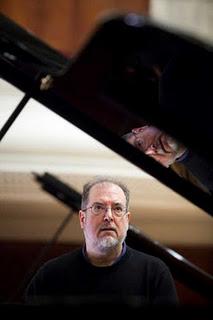
Piano reflections: Garrick Ohlsson.
On Sunday afternoon, piano lovers took a break from the NFL playoffs to see the piano giant Garrick Ohlsson do battle with the Hungarian patriot Franz Liszt at the 92nd St. Y. Mr. Ohlsson offered a program displaying stunning technique, split between familiar, but challenging works and serious examples of the composer's catalog.
Mr. Ohlsson is a formidibale artist who cemented his reputation recording the complete works of Liszt's friend Chopin. In turning to the flashier Liszt, he brings that same sense of sober, scholarly reconsideration to this familiar music.
Liszt was the masters of the art of transcription, writing over 200 piano pieces adapted from orchestral music, songs, or other instruments. Fittingly, the concert opened with his piano version of Bach's Fantasia and Fugue in G minor.
This is a famous organ work, a vast exploration of the cosmos through the complexity of Bach's figured bass. Mr. Ohlsson leant on his sustain pedal to create the ringing, overlapping sounds of Bach's organ. He then lifted his massive right foot for the fugue, playing with the delicate lines with a light touch that belied the complex sounds that blossomed forth as the work came to its climax.
Inspired by Schubert's Wanderer-Fantasie, Liszt's Sonata in B Minor revolutionized the form by condensing four movements into one. Mr. Ohlsson used tremendous hand and wrist control to explore its complexities. The last two movements, a harrowing ride into the piano's minor-key bass register was followed by a slow elevation to the more blessed upper regions of the keyboard.
The second half of the concert featured four of Liszt's most compelling virtuoso pieces, displaying different aspects of both the soloist and instrument. As the recital progressed, it was clear that Mr. Ohlsson was presenting these four works as a kind of pastiche sonata, a mega-work for keyboard on a massive scale.
Les jeux d'eaux à la Villa d'Este is from Liszt's late period, and points the way towards Debussy and Ravel. Feux follets is fiendishly difficult, demanding fast, light playing from the soloist. And the opening of the Funérailles contains, among other things, the inspiration for the bells of Wagner's Parsifal.
This tour concluded with another devilishly challenging work, the Mephisto Waltz No. 1. Based on an episode from Nicholas Lenau's Faust, the Waltz recreates dancing villagers and the devil's fiddle from that legend. The staccato rhythms with great control, giving way to virtuoso runs that seemed to explode from the lid of the piano.
One encore was offered: the searching, inpressionistic Klavierstücke in A. These floating, fragmented melodies were played with restraint and beautiful tone. This rarely heard abstraction showed that even in his last years, Franz Liszt still pointed the way forwrd.

